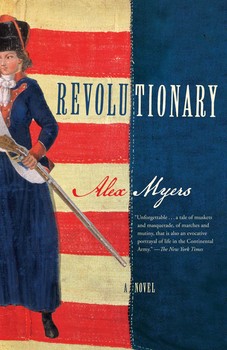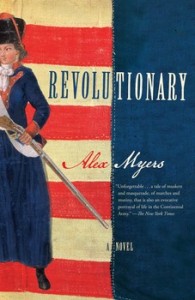Do Clothes Make the Man?

When my history classes meet, there sit my female students, virtually every one of them wearing jeans, a clothing choice that was once understood as transgressive crossdressing, but which now scarcely invites comment. But as many of them report, even though high school girls are allowed to wear pants, school authorities discipline girls for perceived sexuality in their clothing, while peers often brutally punish boys for signs of femininity. Clothes have been and remain key to identity, and issues of identity of multiple kinds are in the forefront of our students’ minds. In Revolutionary, Alex Myers recounts an early chapter in the history of crossdressing by imagining the life of Deborah Sampson, a woman who disguised herself as a Continental soldier. In choosing to tell that story through the historical novel, he challenges the boundaries between fact and fiction as well as between male and female. For teachers, Myers raises the question: what is the place of fiction in history pedagogy?
As a literary work, Revolutionary is highly capable, a good read that creates believable characters, employs telling detail and maintains suspense: will Deborah Sampson be accepted as Robert Shurtliff? It begins with her determination to enlist despite an initial failure to fool recruiters, an attempt for which she may be prosecuted. After a rape that captures women’s physical, sexual and legal vulnerability, Sampson runs away and convinces a Continental recruiter to accept her. Appropriately, she serves mainly in New York’s “neutral ground,” an area notable for shifting loyalties and the difficulty of determining Loyalists from Patriots. Deborah/Robert bonds with other soldiers, kills and is wounded, falls in love with a comrade who accepts her masquerade, has her secret exposed during an illness, and is last seen, years later, on the popular stage, where she tells her story as a woman, but brings down the house by performing military maneuvers.
The marketing of Myers’s novel has emphasized that he is a transgender author and activist, but he is careful not to project contemporary identity categories and assumptions onto his fictional account of the past. Initially, Sampson does not so much perceive herself as or want to be a man as to have men’s opportunities. She thrills to the Patriot cause, but her motivation is essentially personal and proto-feminist. No man wants to marry her and she senses “a world out there . . . beyond weaving, beyond housework,” beyond women’s “proper sphere” (3). But to get those opportunities, she has to transform her person, a “thrilling, head-spinning” metamorphosis that in Myers’ expert telling is detailed, complex and riveting (23). Each aspect of her new appearance—short hair, bound breasts, lower voice, Continental uniform, lengthened stride—is transgressive and dangerous. “How easily they accepted her as another recruit … how quickly they would turn on her if they knew. Her clothes were like an eggshell about her, a thin layer of protection, a veneer that both kept out and held in” (55).
This transformation prompts the newly created Robert Shurtliff to repeated musings on what makes a man a man. Initially, she sees men as sure of themselves, a mix of cockiness and competence, but her fellow soldiers include traitors, cowards and hotheads, as well as those cool under fire. During their first engagement, Shurtliff proves the first to kill. “That soldier is a man,” her officer declares (124). Shurtliff becomes the man others want to imitate, even as he is imitating others. Having definitively asserted manliness in battle, he enjoys male camaraderie: same-sex dancing, drinking, and sharing a bed. After a contest in which Robert turns out to spit like a girl, a soldier shrugs, “You may not know how to spit, but you can kill” (131). For Myers, gender identity is not interior and fixed, but a combination of who you decide to be and who society assumes you are. “A cantankerous woman equaled a mild man,” Sampson quickly finds (75). The army seems to literally build men: “He was strong or smart, naïve or helpful, because of what the corporals or sergeants asked of him, because of what his fellows thought of him,” Myers writes (155). But as Deborah’s sense of competence and entitlement expands, she becomes someone else, her own creation, both Robert and Deborah.
In seeing identity construction as a negotiated performance, Myers reflects the historical literature, as does his representation of eighteenth-century friendship, masculinity, soldiering, and material culture. Revolutionary’s plot necessarily draws on earlier histories, such as Alfred F. Young’s Masquerade: The Life and Times of Deborah Sampson, Continental Soldier (2004). The temptation to move beyond history and imagine Sampson’s experience appeared early in his subject’s life, as witness Herman Mann’s 1797 The Female Review: or, Memoirs of an American Young Lady, which was as much novel as memoir. While largely avoiding anachronisms (excepting overly modern letters interspersed in the narrative) and accurately incorporating the historical context, as a novelist Myers engages in wholesale re-imagining. Sampson’s rape and her love affair might have happened, but no documents confirm that they did. Similarly, we know that Sampson/Shurtliff fought and was injured in engagements, but we don’t know that she killed anyone, despite Myers’ emphasis on that experience. Even well-researched fiction is still fiction, and, setting aside academic debates about the instability of meaning and student propensity to call all texts “novels,” why read or assign historical fiction? If Myers gains from historical accounts such as Young’s, what do historians and students gain from his fiction?
As classroom texts, Masquerade and Revolutionary have very different uses. Young’s book reveals the process of constructing historical knowledge from equivocal sources. He is himself a character in his book, as he searches for, collects, and comments on each document he finds, and often admits that he doesn’t know what happened, and that no one ever will. Masquerade’s great excitement is the historical chase, and Sampson emerges through that superbly told story. By contrast, Myers’ interpretive choices are hidden from the reader and he asserts imagined experiences and feelings as if they were given realities—a temptation to students. The careful historian and the presumptuous novelist would seem at odds, but Myers uses his imaginative skills with a purpose immediately recognizable to any scholar of eighteenth-century fiction: to stimulate his audience’s “affections” through participation in another’s experience. Myers proves remarkably adept at shaping and shifting the reader’s feelings and reactions to Sampson’s gender. Sampson is “she” and Deborah when she is a frustrated weaver and servant victimized by men and just beginning her masquerade; then becomes “he” and Robert Shurtliff/Bob as an enlisted soldier; and is Deborah/she again when her biological gender is revealed. During the long middle section, Deborah so thoroughly becomes Robert that I initially perceived his love for a fellow soldier as a same-sex relationship. Their mutual attraction and hesitant daydreams of a postwar life together suggest that Sampson’s initial desire for men’s opportunities has become something more. Appropriately enough, Young calls his book Masquerade and Myers calls his Revolutionary. Both, however, end with Deborah contracting a disappointing marriage and wistfully recalling her brief interlude as a man.
It is a mark of this book’s richness that it suggests so many possibilities for use. While it is part of a very recent national conversation on identity and transgendering, it reminds us of the many earlier fictions that explored crossdressing, such as Lillie Devereux Blake’s Fettered for Life or, Lord and Master: A Story of To-Day (1874), a women’s rights tale with a jaw-dropping conclusion. Crossdressing is only a small part of a larger American concern for deception, as witness everything from seduction and betrayal novels to paranoid politics to etiquette books to the confidence man. Is anyone as he—or she—seems? And if clothes can “make” a woman a man, however briefly, what can make a man a woman? We know that in religious conversions, men often acted and spoke a woman’s part, a metaphorical if not sartorial crossdressing. War might also complicate gender. As Revolutionary ends and Robert becomes Deborah again, Myers seems to be suggesting a third gender or identity: soldiers, whose violent experiences separate them from most men as well as women. In a sense, they could never remove their uniforms. Michael Shaara’s The Killer Angels, that staple Civil War fiction, conveys much the same message. How could life be the same after Gettysburg? Ulysses S. Grant himself commented on how battle might upend gender when he spoke of General Joshua Chamberlain having “the soul of the lion and the heart of the woman.” There seems to be no end of possibilities for how we clothe our identity.
This article originally appeared in issue 16.2.5 (Spring, 2016).
Martha Tomhave Blauvelt, author of The Work of the Heart: Young Women and Emotion, 1780-1830 (2007), is professor emerita of Gender Studies, College of St. Benedict/St. John’s University.
